Measuring Understory Fire Effects from Space: Canopy Change in Response to Tropical Understory Fire and What This Means for Applications of GEDI to Tropical Forest Fire
Abstract
1. Introduction
2. Materials and Methods
2.1. Concept and Workflow
2.2. Study Area
2.3. Data Inputs
2.3.1. Airborne Laser Scanning Data
2.3.2. GEDI Simulation
2.4. Sampling Design
2.4.1. Fire Mapping
2.4.2. Forest Edge Classification
2.5. Statistical Analysis
2.5.1. Objective 1: Measure Changes in Canopy Structure
2.5.2. Objective 2: Quantify Fire Severity
2.5.3. Objective 3: Assess Applicability of On-Orbit GEDI
3. Results
3.1. Changes in Canopy Structure
3.1.1. Plant Area Index Response
3.1.2. Relative Height Curve Response
3.2. Fire Severity
3.3. Applicability of On-Orbit GEDI
3.3.1. Burn Severity
3.3.2. Forest Structural Change
4. Discussion
4.1. Fire Effects
4.2. Applications of On-Orbit GEDI
4.3. Conclusions
Author Contributions
Funding
Data Availability Statement
Acknowledgments
Conflicts of Interest
Appendix A
| Site Name | Flight Codes | Number of ALS Tiles | Area Covered | Average Return Density (points/m2) | Date (Day–Month–Year) |
|---|---|---|---|---|---|
| Bonal | BON_A01_2013_LiDAR | 14 | 600 ha | 33.39 | 16 September 2013 |
| Humaitá | HUM_A01_2013_LiDAR | 12 | 500 ha | 66.61 | 15 September 2013 |
| Rio Branco | RIB_A01_2014_LiDAR | 18 | 1000 ha | 71.74 | 12 April 2015 |
| Talismã | TAL_A01_2013_LiDAR | 12 | 500 ha | 40.7 | 29 May 2014 |
| 0–5 | 5–10 | 10–15 | 15–20 | 20–25 | 25–30 | 30–35 | 35–40 | 40–45 | 45–50 | 50–55 | 55–60 | |
|---|---|---|---|---|---|---|---|---|---|---|---|---|
| Burned | 288 | 288 | 288 | 287 | 287 | 282 | 253 | 190 | 85 | 17 | 3 | 1 |
| Unburned | 288 | 288 | 288 | 287 | 286 | 285 | 271 | 213 | 110 | 29 | 6 | 0 |
References
- Laurance, W.F. A Crisis in the Making: Responses of Amazonian Forests to Land Use and Climate Change. Trends Ecol. Evol. 1998, 13, 411–415. [Google Scholar] [CrossRef] [PubMed]
- Cochrane, M.A.; Schulze, M.D. Fire as a Recurrent Event in Tropical Forests of the Eastern Amazon: Effects on Forest Structure, Biomass, and Species Composition. Biotropica 1999, 31, 2–16. [Google Scholar] [CrossRef]
- Longo, M.; Keller, M.; dos-Santos, M.N.; Leitold, V.; Pinagé, E.R.; Baccini, A.; Saatchi, S.; Nogueira, E.M.; Batistella, M.; Morton, D.C. Aboveground Biomass Variability across Intact and Degraded Forests in the Brazilian Amazon. Glob. Biogeochem. Cycles 2016, 30, 1639–1660. [Google Scholar] [CrossRef]
- Curtis, P.G.; Slay, C.M.; Harris, N.L.; Tyukavina, A.; Hansen, M.C. Classifying Drivers of Global Forest Loss. Science 2018, 361, 1108–1111. [Google Scholar] [CrossRef] [PubMed]
- Matricardi, E.A.T.; Skole, D.L.; Costa, O.B.; Pedlowski, M.A.; Samek, J.H.; Miguel, E.P. Long-Term Forest Degradation Surpasses Deforestation in the Brazilian Amazon. Science 2020, 369, 1378–1382. [Google Scholar] [CrossRef]
- Morgan, W.T.; Darbyshire, E.; Spracklen, D.; Artaxo, P.; Coe, H. Non-Deforestation Drivers of Fires Are Increasingly Important Sources of Aerosol and Carbon Dioxide Emissions across Amazonia. Sci. Rep. 2019, 9, 1–15. [Google Scholar] [CrossRef]
- Cochrane, M.A.; Alencar, A.; Schulze, M.D.; Souza, C.M.; Nepstad, D.C.; Lefebvre, P.; Davidson, E.A. Positive Feedbacks in the Fire Dynamic of Closed Canopy Tropical Forests. Science 1999, 284, 1832–1835. [Google Scholar] [CrossRef]
- Hoffmann, W.A.; Jaconis, S.Y.; Mckinley, K.L.; Geiger, E.L.; Gotsch, S.G.; Franco, A.C. Fuels or Microclimate? Understanding the Drivers of Fire Feedbacks at Savanna-Forest Boundaries. Austral Ecol. 2012, 37, 634–643. [Google Scholar] [CrossRef]
- Alencar, A.; Nepstad, D.; del Carmen Vera Diaz, M. Forest Understory Fire in the Brazilian Amazon in ENSO and Non-ENSO Years: Area Burned and Committed Carbon Emissions. Earth Interact. 2006, 10, 1–17. [Google Scholar] [CrossRef]
- Jimenez, J.C.; Libonati, R.; Peres, L.F. Droughts Over Amazonia in 2005, 2010, and 2015: A Cloud Cover Perspective. Front. Earth Sci. 2018, 6, 1–7. [Google Scholar] [CrossRef]
- Cox, P.M.; Betts, R.A.; Collins, M.; Harris, P.P.; Huntingford, C.; Jones, C.D. Amazonian Forest Dieback under Climate-Carbon Cycle Projections for the 21st Century. Appl. Clim. 2004, 78, 137–156. [Google Scholar] [CrossRef]
- Nobre, C.; Obregón, G.; Marengo, J.; Fu, R.; Poveda, G. Characteristics of Amazonian Climate: Main Features. In Amazonia and Global Change; Keller, M., Bustamante, M., Gash, J., Silva Dias, P., Eds.; John Wiley & Sons, Inc.: Hoboken, NJ, USA, 2009. [Google Scholar]
- Wright, S.J. Plant Diversity in Tropical Forests: A Review of Mechanisms of Species Coexistence. Oecologia 2002, 130, 1–14. [Google Scholar] [CrossRef]
- Global Fire Emissions Database Amazon Dashboard. Available online: https://globalfiredata.org/pages/amazon-dashboard/ (accessed on 1 April 2021).
- Rappaport, D.I.; Morton, D.C.; Longo, M.; Keller, M.; Dubayah, R.; Dos-Santos, M.N. Quantifying Long-Term Changes in Carbon Stocks and Forest Structure from Amazon Forest Degradation. Environ. Res. Lett. 2018, 13, 065013. [Google Scholar] [CrossRef]
- Barlow, J.; Peres, C.A. Ecological Responses to El Niño-Induced Surface Fires in Central Brazilian Amazonia: Management Implications for Flammable Tropical Forests. Philos. Trans. R. Soc. B Biol. Sci. 2004, 359, 367–380. [Google Scholar] [CrossRef]
- Silva, C.V.J.; Aragão, L.E.O.C.; Barlow, J.; Espirito-Santo, F.; Young, P.J.; Anderson, L.O.; Berenguer, E.; Brasil, I.; Brown, I.F.; Castro, B.; et al. Drought-Induced Amazonian Wildfires Instigate a Decadal-Scale Disruption of Forest Carbon Dynamics. Philos. Trans. R. Soc. B Biol. Sci. 2018, 8, 373. [Google Scholar] [CrossRef]
- Silva, C.H.L.; Aragão, L.E.O.C.; Anderson, L.O.; Fonseca, M.G.; Shimabukuro, Y.E.; Vancutsem, C.; Achard, F.; Beuchle, R.; Numata, I.; Silva, C.A.; et al. Persistent Collapse of Biomass in Amazonian Forest Edges Following Deforestation Leads to Unaccounted Carbon Losses. Sci. Adv. 2020, 6, aaz8360. [Google Scholar] [CrossRef]
- Laurance, W.F.; Nascimento, H.E.M.; Laurance, S.G.; Andrade, A.C.; Fearnside, P.M.; Ribeiro, J.E.L.; Capretz, R.L. Rain Forest Fragmentation and the Proliferation of Successional Trees. Ecology 2006, 87, 469–482. [Google Scholar] [CrossRef]
- Malcolm, J.R. Edge Effects in Central Amazonian Forest Fragments. Ecology 1994, 75, 2438–2445. [Google Scholar]
- Nepstad, D.C.; Stickler, C.M.; Soares-Filho, B.; Merry, F. Interactions among Amazon Land Use, Forests and Climate: Prospects for a near-Term Forest Tipping Point. Philos. Trans. R. Soc. B Biol. Sci. 2008, 363, 1737–1746. [Google Scholar] [CrossRef]
- Armenteras, D.; Meza, M.C.; González, T.M.; Oliveras, I.; Balch, J.K.; Retana, J. Fire Threatens the Diversity and Structure of Tropical Gallery Forests. Ecosphere 2021, 12, 3347. [Google Scholar] [CrossRef]
- Miller, J.D.; Thode, A.E. Quantifying Burn Severity in a Heterogeneous Landscape with a Relative Version of the Delta Normalized Burn Ratio (DNBR). Remote Sens. Environ. 2007, 109, 66–80. [Google Scholar] [CrossRef]
- Roy, D.P.; Boschetti, L.; Trigg, S.N. Remote Sensing of Fire Severity: Assessing the Performance of the Normalized Burn Ratio. IEEE Geosci. Remote Sens. Lett. 2006, 3, 112–116. [Google Scholar] [CrossRef]
- Hu, T.; Ma, Q.; Su, Y.; Battles, J.J.; Collins, B.M.; Stephens, S.L.; Kelly, M.; Guo, Q. A Simple and Integrated Approach for Fire Severity Assessment Using Bi-Temporal Airborne LiDAR Data. Int. J. Appl. Earth Obs. Geoinf. 2019, 78, 25–38. [Google Scholar] [CrossRef]
- García, M.; North, P.; Viana-Soto, A.; Stavros, N.E.; Rosette, J.; Martín, M.P.; Franquesa, M.; González-Cascón, R.; Riaño, D.; Becerra, J.; et al. Evaluating the Potential of LiDAR Data for Fire Damage Assessment: A Radiative Transfer Model Approach. Remote Sens. Environ. 2020, 247, 111893. [Google Scholar] [CrossRef]
- Fernandez-Manso, A.; Quintano, C.; Roberts, D.A. Burn Severity Analysis in Mediterranean Forests Using Maximum Entropy Model Trained with EO-1 Hyperion and LiDAR Data. ISPRS J. Photogramm. Remote Sens. 2019, 155, 102–118. [Google Scholar] [CrossRef]
- Chuvieco, E.; Aguado, I.; Salas, J.; García, M.; Yebra, M.; Oliva, P. Satellite Remote Sensing Contributions to Wildland Fire Science and Management. Curr. For. Rep. 2020, 6, 81–96. [Google Scholar] [CrossRef]
- Liu, M.; Popescu, S.; Malambo, L. Feasibility of Burned Area Mapping Based on ICESAT-2 Photon Counting Data. Remote Sens. 2020, 12, 24. [Google Scholar] [CrossRef]
- Skowronski, N.S.; Gallagher, M.R.; Warner, T.A. Decomposing the Interactions between Fire Severity and Canopy Fuel Structure Using Multi-Temporal, Active, and Passive Remote Sensing Approaches. Fire 2020, 3, 7. [Google Scholar] [CrossRef]
- Pontes-Lopes, A.; Dalagnol, R.; Dutra, A.C.; de Jesus Silva, C.V.; de Alencastro Graça, P.M.L.; de Oliveira e Cruz de Aragão, L.E. Quantifying Post-Fire Changes in the Aboveground Biomass of an Amazonian Forest Based on Field and Remote Sensing Data. Remote Sens. 2022, 14, 1545. [Google Scholar] [CrossRef]
- Dubayah, R.; Blair, J.B.; Goetz, S.; Fatoyinbo, L.; Hansen, M.; Healey, S.; Hofton, M.; Hurtt, G.; Kellner, J.; Luthcke, S.; et al. The Global Ecosystem Dynamics Investigation: High-Resolution Laser Ranging of the Earth’s Forests and Topography. Sci. Remote Sens. 2020, 1, 100002. [Google Scholar] [CrossRef]
- Beck, J.; Armston, J.; Hofton, M.; Luthcke, S. GLOBAL Ecosystem Dynamics Investigation (GEDI) Level 02 User Guide For SDPS PGEVersion 1 (P001) of GEDI L2A Data and SDPS PGE Version 1 (P001) of GEDI L2B Data; 2020; Volume 1.0. Available online: https://lpdaac.usgs.gov/documents/589/GEDIL02_User_Guide_V1.pdf (accessed on 1 March 2022).
- Leite, R.V.; Silva, C.A.; Broadbent, E.N.; do Amaral, C.H.; Liesenberg, V.; de Almeida, D.R.A.; Mohan, M.; Godinho, S.; Cardil, A.; Hamamura, C.; et al. Large Scale Multi-Layer Fuel Load Characterization in Tropical Savanna Using GEDI Spaceborne Lidar Data. Remote Sens. Environ. 2022, 268, 112764. [Google Scholar] [CrossRef]
- East, A.; Hansen, A.J.; Jantz, P.A.; Roberts, D.; Armenteras-Pascual, D. Validation and Error Minimization of GEDI Data in the Amazon. Remote Sens. Environ. 2022; in review. [Google Scholar]
- Roy, D.P.; Kashongwe, H.B.; Armston, J. The Impact of Geolocation Uncertainty on GEDI Tropical Forest Canopy Height Estimation and Change Monitoring. Sci. Remote Sens. 2021, 4, 100024. [Google Scholar] [CrossRef]
- Balch, J.K.; Nepstad, D.C.; Curran, L.M.; Brando, P.M.; Portela, O.; Guilherme, P.; Reuning-Scherer, J.D.; de Carvalho, O. Size, Species, and Fire Behavior Predict Tree and Liana Mortality from Experimental Burns in the Brazilian Amazon. Ecol. Manag. 2011, 261, 68–77. [Google Scholar] [CrossRef]
- Santos, R.; Galvão, L.S.; Journal, S.; November, N.; Ramos, S.; Martins, V.; Abrahim, H.; Xaud, M.; Roberto, J. Effects of Fire on Above-Ground Forest Biomass in the Northern Brazilian Amazon. J. Trop. Ecol. 2012, 28, 591–601. [Google Scholar] [CrossRef]
- Sato, L.Y.; Gomes, V.C.F.; Shimabukuro, Y.E.; Keller, M.; Arai, E.; dos-Santos, M.N.; Brown, I.F.; de Aragão, L.E.O.e.C. Post-Fire Changes in Forest Biomass Retrieved by Airborne LiDAR in Amazonia. Remote Sens. 2016, 8, 839. [Google Scholar] [CrossRef]
- Hancock, S.; Armston, J.; Hofton, M.; Sun, X.; Tang, H.; Duncanson, L.I.; Kellner, J.R.; Dubayah, R. The GEDI Simulator: A Large-Footprint Waveform Lidar Simulator for Calibration and Validation of Spaceborne Missions. Earth Space Sci. 2019, 6, 294–310. [Google Scholar] [CrossRef]
- Dos-Santos, M.N.; Keller, M.M.; Morton, D.C. LiDAR Surveys over Selected Forest Research Sites, Brazilian Amazon, 2008–2018. 2019. Available online: https://daac.ornl.gov/CMS/guides/LiDAR_Forest_Inventory_Brazil.html (accessed on 8 November 2022).
- Hofton, M.A.; Minster, J.B.; Blair, J.B. Decomposition of Laser Altimeter Waveforms. IEEE Trans. Geosci. Remote Sens. 2000, 38, 1989–1996. [Google Scholar] [CrossRef]
- Tang, H.; Dubayah, R.; Swatantran, A.; Hofton, M.; Sheldon, S.; Clark, D.B.; Blair, B. Retrieval of Vertical LAI Profiles over Tropical Rain Forests Using Waveform Lidar at La Selva, Costa Rica. Remote Sens Environ. 2012, 124, 242–250. [Google Scholar] [CrossRef]
- Blair, J.B.; Hofton, M.A. Modeling Laser Altimeter Return Waveforms over Complex Vegetation Using High-Resolution Elevation Data. Geophys. Res. Lett. 1999, 26, 2509–2512. [Google Scholar] [CrossRef]
- Boucher, P.B.; Hancock, S.; Orwig, D.A.; Duncanson, L.; Armston, J.; Tang, H.; Krause, K.; Cook, B.; Paynter, I.; Li, Z.; et al. Detecting Change in Forest Structure with Simulated GEDI Lidarwaveforms: A Case Study of the Hemlock Woolly Adelgid (HWA.; Adelges Tsugae) Infestation. Remote Sens. 2020, 12, 1304. [Google Scholar] [CrossRef]
- Dubayah, R.O.; Sheldon, S.L.; Clark, D.B.; Hofton, M.A.; Blair, J.B.; Hurtt, G.C.; Chazdon, R.L. Estimation of Tropical Forest Height and Biomass Dynamics Using Lidar Remote Sensing at La Selva, Costa Rica. J. Geophys. Res. Biogeosci. 2010, 115, 1–17. [Google Scholar] [CrossRef]
- Duncanson, L.; Kellner, J.R.; Armston, J.; Dubayah, R.; Minor, D.M.; Hancock, S.; Healey, S.P.; Patterson, P.L.; Saarela, S.; Marselis, S.; et al. Aboveground Biomass Density Models for NASA’s Global Ecosystem Dynamics Investigation (GEDI) Lidar Mission. Remote Sens. Environ. 2022, 270, 112845. [Google Scholar] [CrossRef]
- Schneider, F.D.; Ferraz, A.; Hancock, S.; Duncanson, L.I.; Dubayah, R.O.; Pavlick, R.P.; Schimel, D.S. Towards Mapping the Diversity of Canopy Structure from Space with GEDI. Environ. Res. Lett. 2020, 15, 115006. [Google Scholar] [CrossRef]
- Beck, J.; Wirt, B.; Armston, J.; Hofton, M.; Luthcke, S.; Tang, H. GLOBAL Ecosystem Dynamics Investigation (GEDI) Level 2 User Guide For SDPS PGEVersion 3 (P003) of GEDI L2A Data and SDPS PGEVersion 3 (P003) of GEDI L2B Data Deputy Principal Investigator and Instrument Scientist User Guide Written by Jared Beck 3 in Coll. 2021; Volume 3, pp. 1–25. Available online: https://lpdaac.usgs.gov/documents/986/GEDI02_UserGuide_V2.pdf (accessed on 2 June 2022).
- Liu, A.; Cheng, X.; Chen, Z. Performance Evaluation of GEDI and ICESat-2 Laser Altimeter Data for Terrain and Canopy Height Retrievals. Remote Sens Environ. 2021, 264, 112571. [Google Scholar] [CrossRef]
- Giglio, L.; Justice, C.; Boschetti, L.; Roy, D. MCD64A1 MODIS/Terra+Aqua Burned Area Monthly L3 Global 500m SIN Grid V006 [Data Set]. NASA EOSDIS Land Process. DAAC 2015. Available online: https://lpdaac.usgs.gov/products/mcd64a1v006/ (accessed on 18 November 2020).
- Alencar, A.A.; Conciani, D.E.; Costa, D.P.; Rosa, E.R.; Martin, E.V.; Hasenack, H.; Martenexen, L.F.M.; Shimbo, J.; Rosa, M.; Crusco, N.; et al. MapBiomas Fire. Algorithm Theoretical Basis Document (ATBD). Collection 1.0. Development 2021. pp. 1–19. Available online: https://mapbiomas-br-site.s3.amazonaws.com/ATBD_MapBiomas_Fogo_Cole%C3%A7%C3%A3o_1.pdf (accessed on 7 December 2021).
- Wacker, A.G.; Landgrebe, D.A. Minimum Distance Classification in Remote Sensing. LARS Technical Reports. 1972, p. 25. Available online: https://docs.lib.purdue.edu/cgi/viewcontent.cgi?article=1024&context=larstech (accessed on 20 April 2022).
- Gorelick, N.; Hancher, M.; Dixon, M.; Ilyushchenko, S.; Thau, D.; Moore, R. Google Earth Engine: Planetary-Scale Geospatial Analysis for Everyone. Remote Sens. Environ. 2017, 202, 18–27. [Google Scholar] [CrossRef]
- Broadbent, E.N.; Asner, G.P.; Keller, M.; Knapp, D.E.; Oliveira, P.J.C.; Silva, J.N. Forest Fragmentation and Edge Effects from Deforestation and Selective Logging in the Brazilian Amazon. Biol. Conserv. 2008, 141, 1745–1757. [Google Scholar] [CrossRef]
- Wilcoxon, F. Individual Comparisons by Ranking Methods. Biom. Bull. 1945, 1, 80–83. [Google Scholar] [CrossRef]
- Hastie, T.; Tibshirani, R. Generalized Additive Models. Stat. Sci. 1990, 1, 297–318. [Google Scholar]
- Tukey, J.W. Comparing Individual Means in the Analysis of Variance. Biometrics 1949, 5, 99–114. [Google Scholar] [CrossRef]
- Wang, C.; Elmore, A.J.; Numata, I.; Cochrane, M.A.; Shaogang, L.; Huang, J.; Zhao, Y.; Li, Y. Factors Affecting Relative Height and Ground Elevation Estimations of GEDI among Forest Types across the Conterminous USA. GIsci. Remote Sens. 2022, 59, 975–999. [Google Scholar] [CrossRef]
- Fayad, I.; Baghdadi, N.; Riedi, J. Quality Assessment of Acquired Gedi Waveforms: Case Study over France, Tunisia and French Guiana. Remote Sens. 2021, 13, 3144. [Google Scholar] [CrossRef]
- Goetz, S.J.; Steinberg, D.; Betts, M.G.; Holmes, R.T.; Doran, P.J.; Dubayah, R.; Hofton, M. Lidar Remote Sensing Variables Predict Breeding Habitat of a Neotropical Migrant Bird. Ecology 2010, 91, 1569–1576. [Google Scholar] [CrossRef]
- Singh, M.; Tokola, T.; Hou, Z.; Notarnicola, C. Remote Sensing-Based Landscape Indicators for the Evaluation of Threatened-Bird Habitats in a Tropical Forest. Ecol. Evol. 2017, 7, 4552–4567. [Google Scholar] [CrossRef]
- Brando, P.M.; Nepstad, D.C.; Balch, J.K.; Bolker, B.; Christman, M.C.; Coe, M.; Putz, F.E. Fire-Induced Tree Mortality in a Neotropical Forest: The Roles of Bark Traits, Tree Size, Wood Density and Fire Behavior. Glob. Chang. Biol. 2012, 18, 630–641. [Google Scholar] [CrossRef]
- Uhl, C.; Kauffman, J.B. Deforestation, Fire Susceptibility, and Potential Tree Responses to Fire in the Eastern Amazon. Ecology 1990, 71, 437–449. [Google Scholar] [CrossRef]
- Balch, J.K.; Brando, P.M.; Nepstad, D.C.; Coe, M.T.; Silvério, D.; Massad, T.J.; Davidson, E.A.; Lefebvre, P.; Oliveira-Santos, C.; Rocha, W.; et al. The Susceptibility of Southeastern Amazon Forests to Fire: Insights from a Large-Scale Burn Experiment. Bioscience 2015, 65, 893–905. [Google Scholar] [CrossRef]
- Numata, I.; Silva, S.S.; Cochrane, M.A.; d’Oliveira, M.V. Fire and Edge Effects in a Fragmented Tropical Forest Landscape in the Southwestern Amazon. Ecol. Manag. 2017, 401, 135–146. [Google Scholar] [CrossRef]
- Keeley, J.E.; Bond, W.J. Mast Flowering and Semelparity in Bamboos: The Bamboo Fire Cycle Hypothesis. Am. Nat. 1999, 154, 383–391. [Google Scholar] [CrossRef] [PubMed]
- Smith, M.; Nelson, B.W. Fire Favours Expansion of Bamboo-Dominated Forests in the South-West Amazon. J. Trop. Ecol. 2011, 27, 59–64. [Google Scholar] [CrossRef]
- Barlow, J.; Silveira, J.M.; Mestre, L.A.M.; Andrade, R.B.; Camacho D’Andrea, G.; Louzada, J.; Vaz-de-Mello, F.Z.; Numata, I.; Lacau, S.; Cochrane, M.A. Wildfires in Bamboo-Dominated Amazonian Forest: Impacts on above-Ground Biomass and Biodiversity. PLoS ONE 2012, 7, 33373. [Google Scholar] [CrossRef]
- Hall, J.V.; Argueta, F.; Giglio, L. Validation of MCD64A1 and FireCCI51 Cropland Burned Area Mapping in Ukraine. Int. J. Appl. Earth Obs. Geoinf. 2021, 102, 102443. [Google Scholar] [CrossRef]
- Tang, H.; Armston, J. Algorithm Theoretical Basis Document (ATBD) for GEDI L2B Footprint Canopy Cover and Vertical Profile Metrics. Version 1.0.; 2019. Available online: https://lpdaac.usgs.gov/documents/588/GEDI_FCCVPM_ATBD_v1.0.pdf (accessed on 13 September 2022).
- Dhargay, S.; Lyell, C.S.; Brown, T.P.; Inbar, A.; Sheridan, G.J.; Lane, P.N.J. Performance of GEDI Space-Borne LiDAR for Quantifying Structural Variation in the Temperate Forests of South-Eastern Australia. Remote Sens. 2022, 14, 3615. [Google Scholar] [CrossRef]
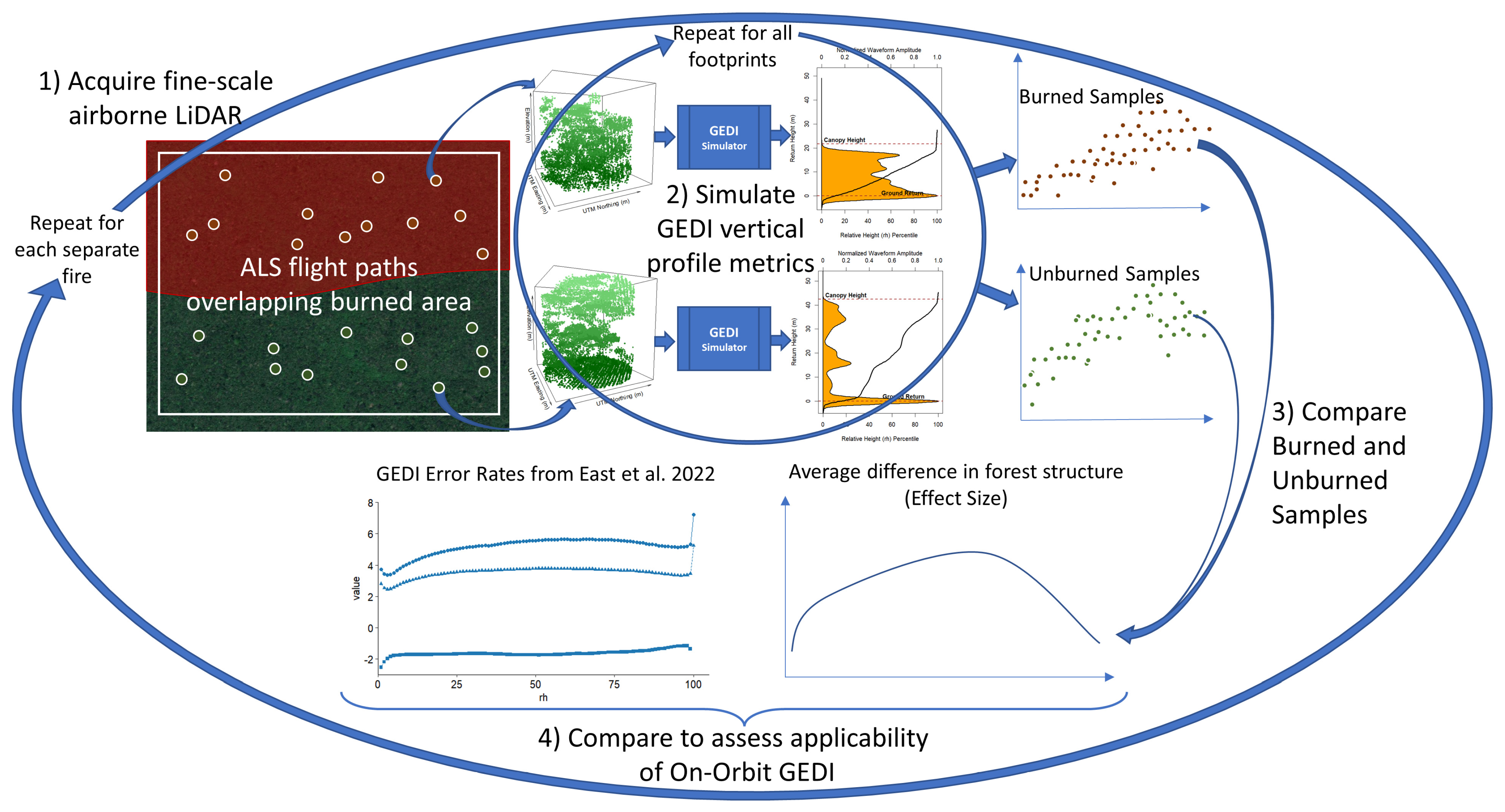
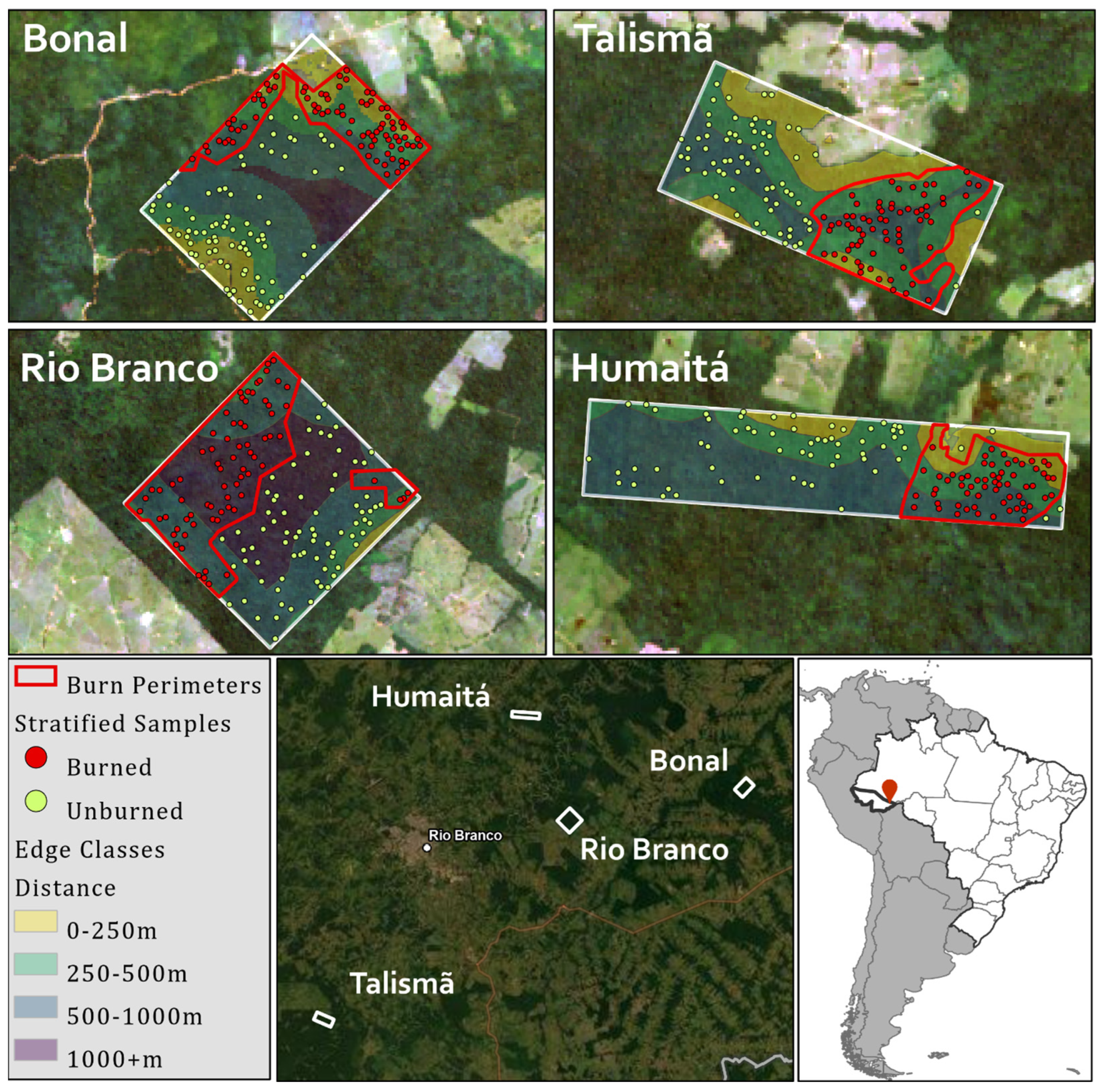
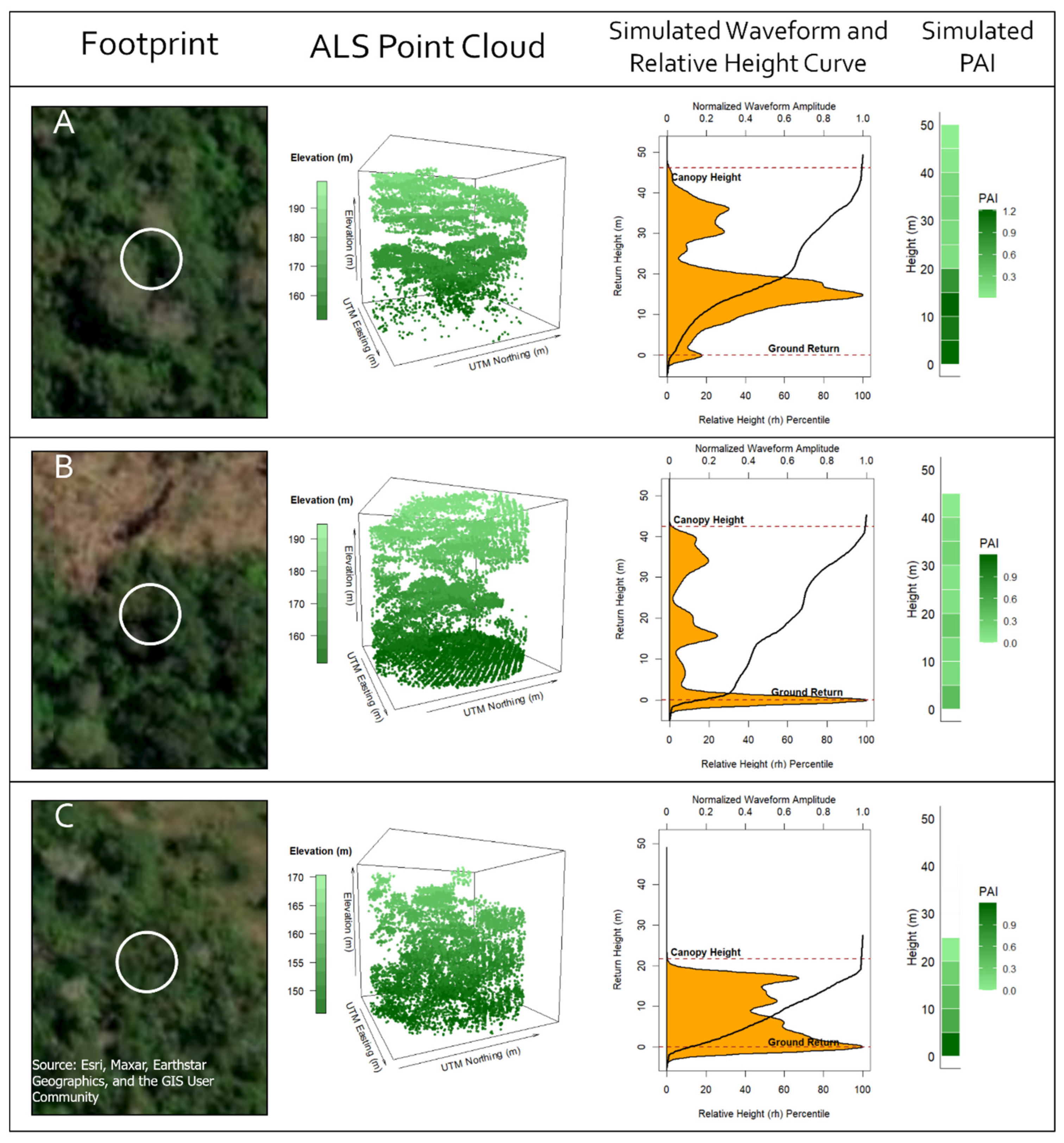
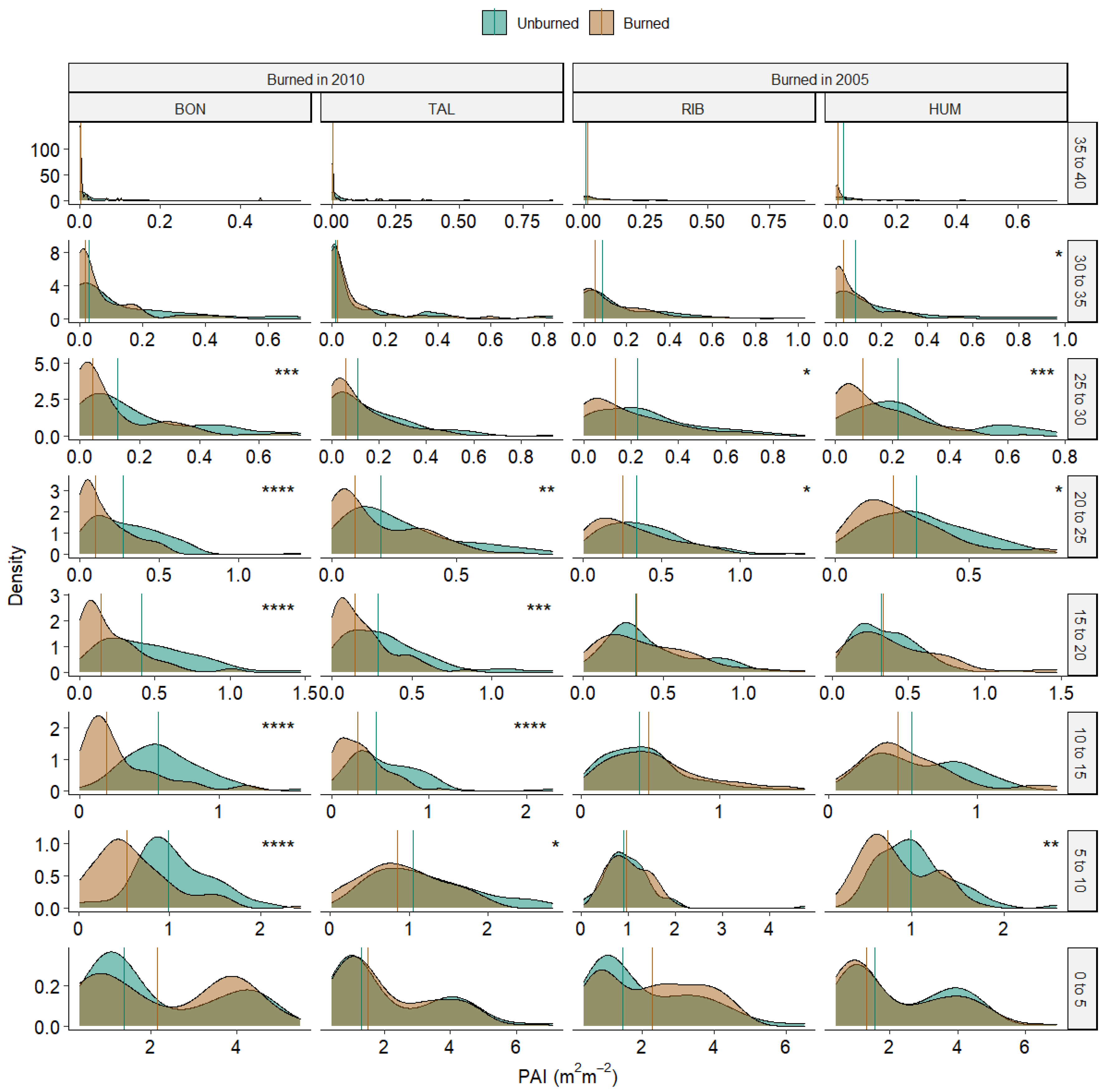

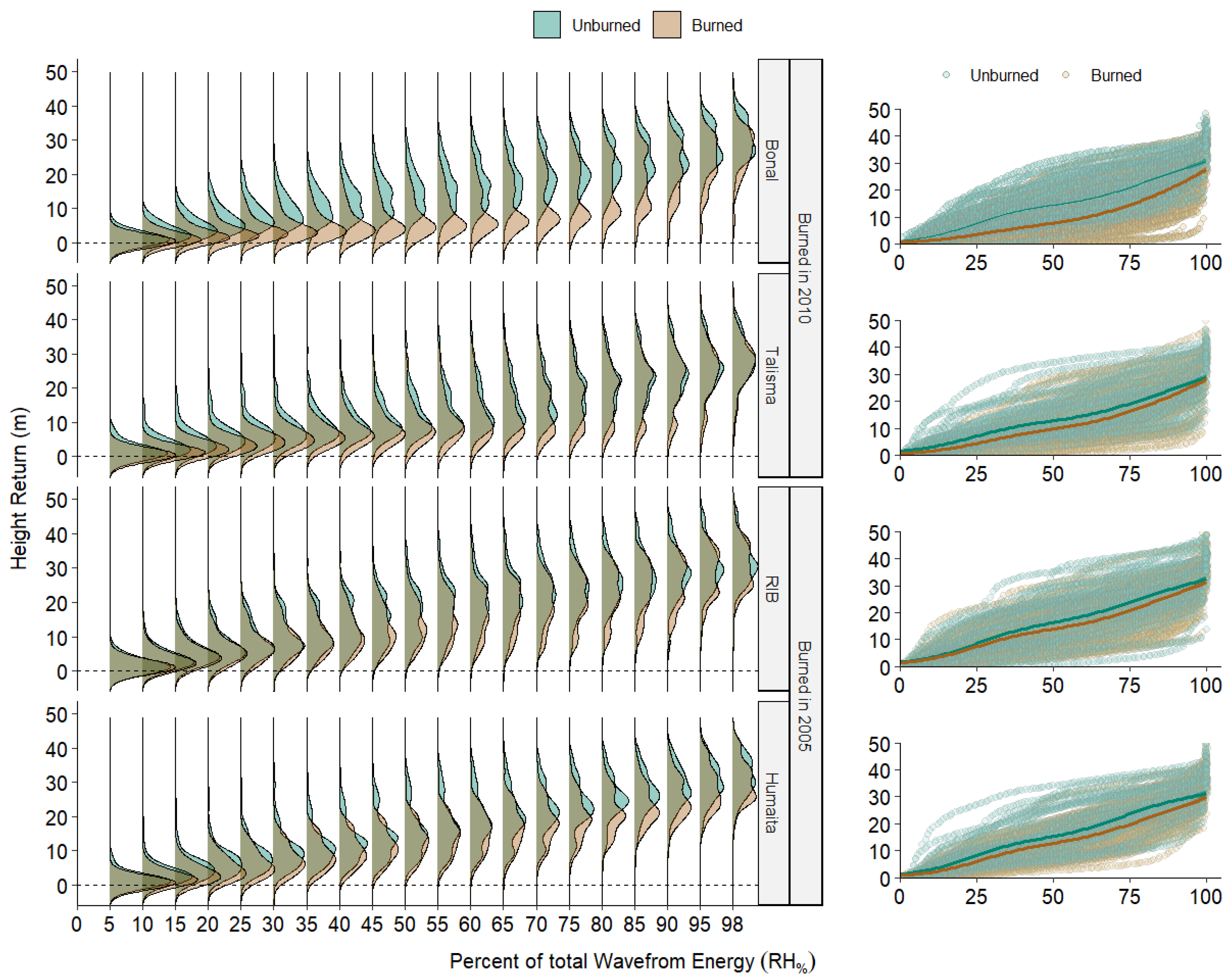
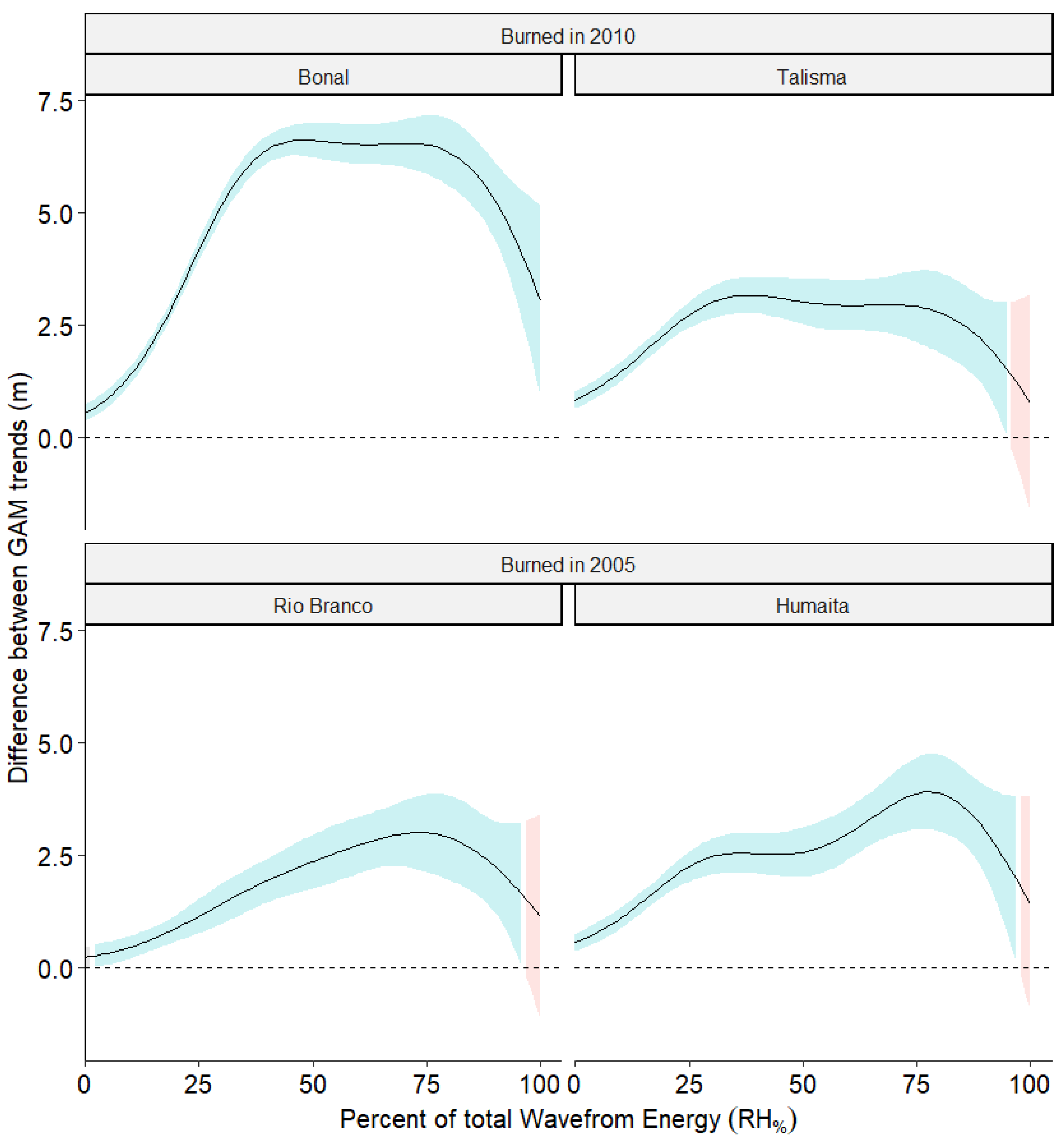
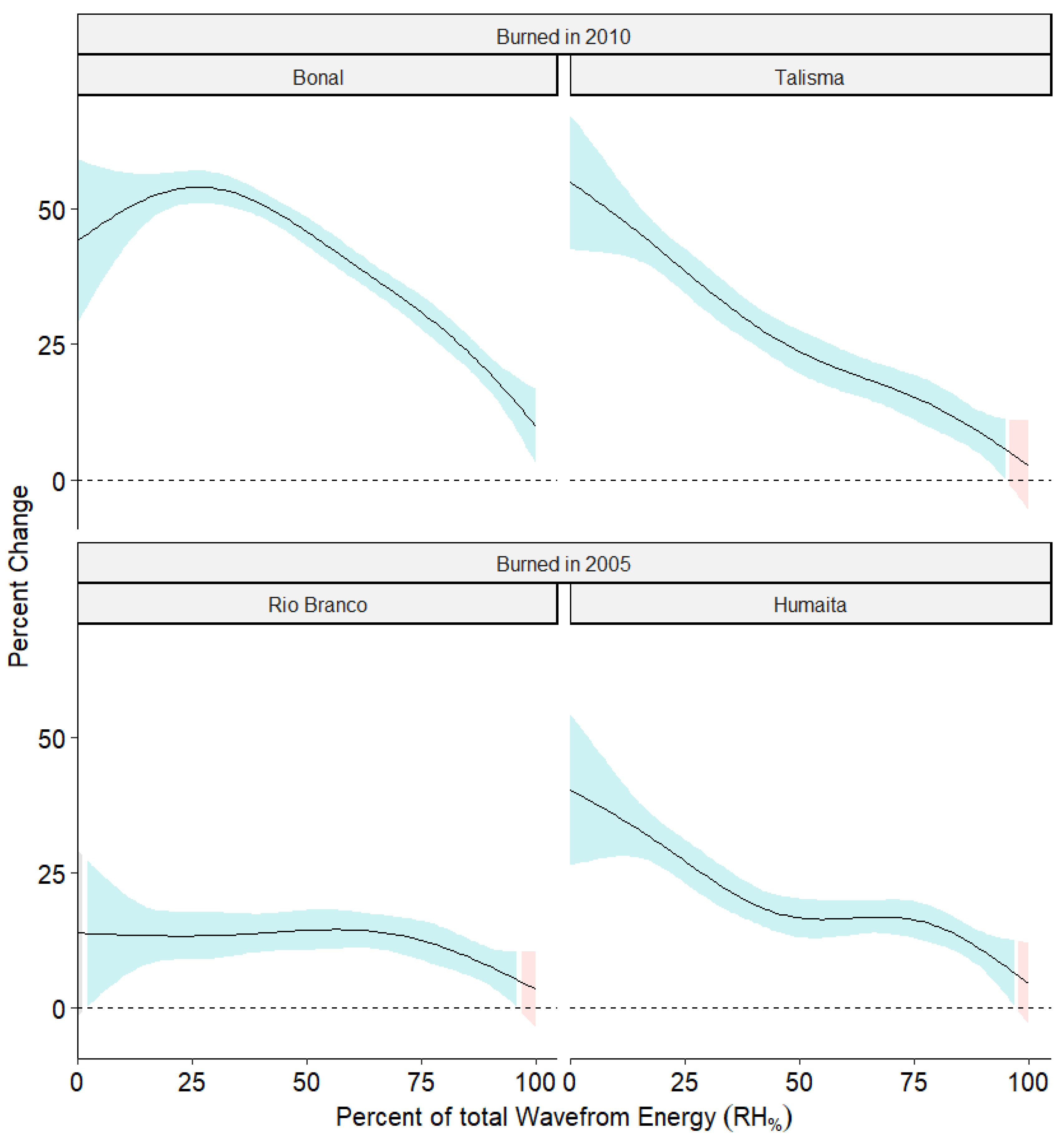
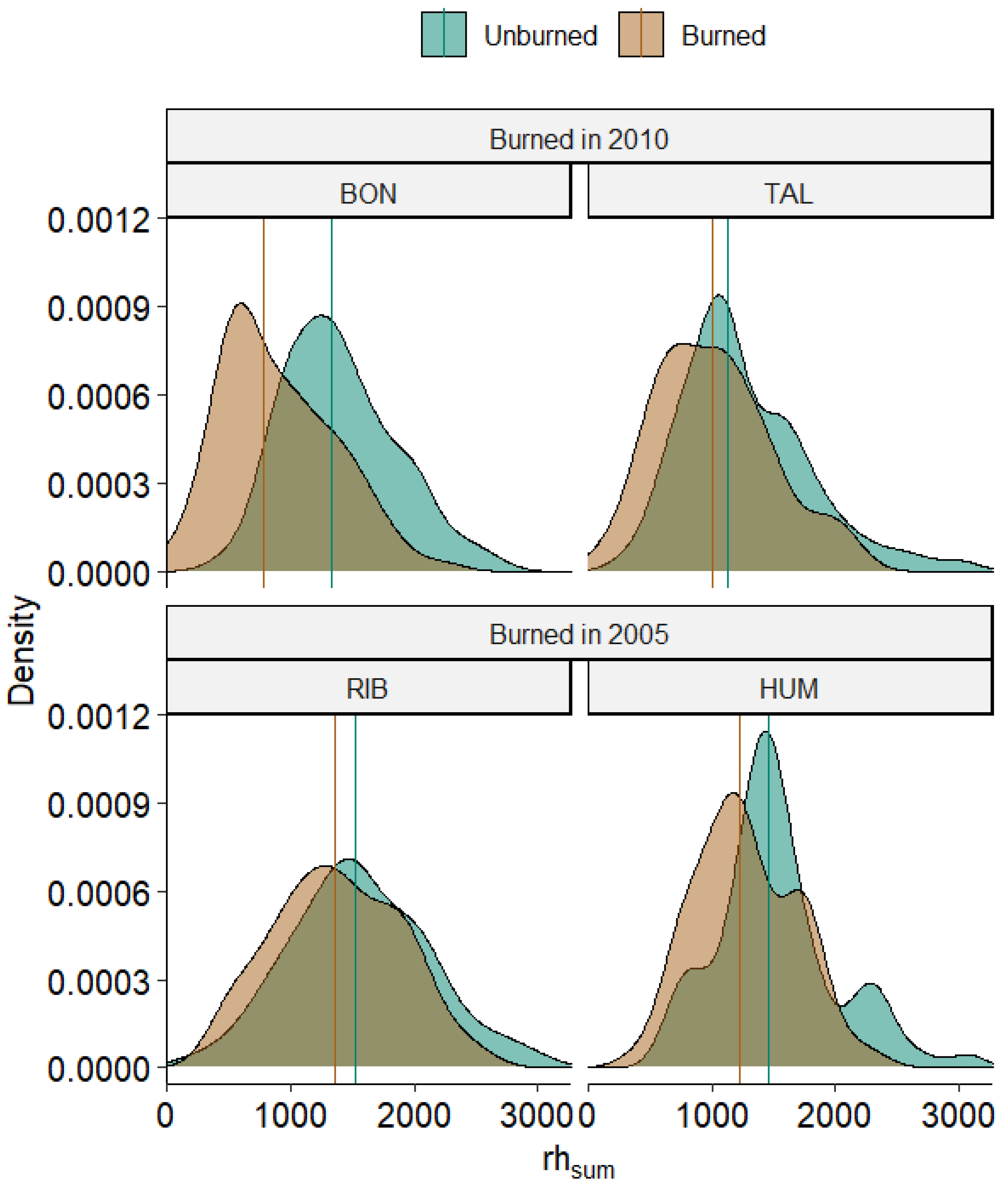
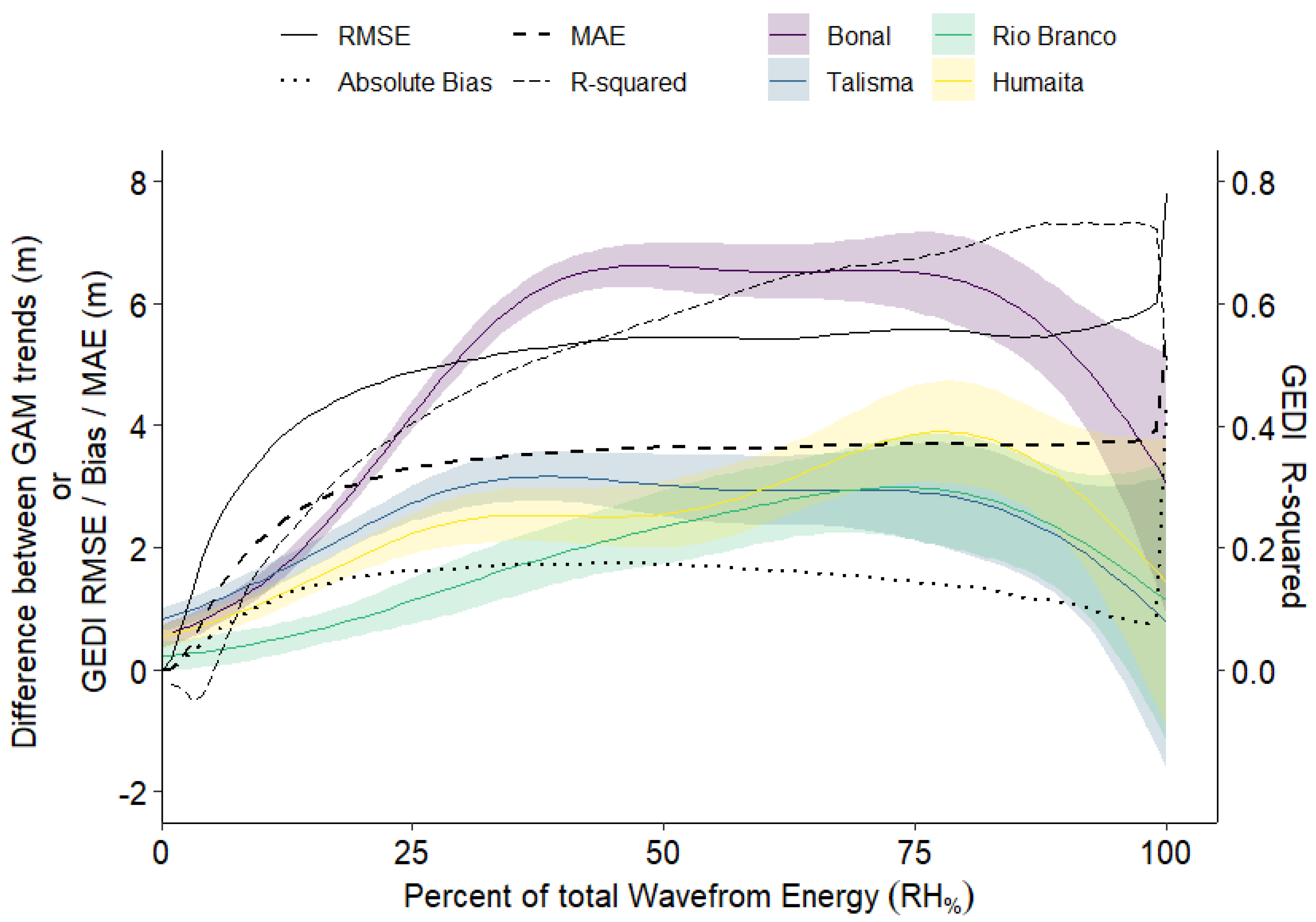
| Forest Type | |||
|---|---|---|---|
| Dense Submontane Rainforests (Emergent) | Open Submontane Rainforests (Bamboo) | ||
| Burned | 2010 | Bonal | Talismã |
| 2005 | Rio Branco | Humaitá | |
| Metric | Definition | Derivation | Ecological Relevance | Units |
|---|---|---|---|---|
| Relative height percentile (RH%) | Percent of total waveform energy (0 to 100%) | Normalized cumulative distribution of the raw waveform (x-axis) | Scales forest canopy distribution to a standardized scale to allow for comparison between sites of different total heights | % |
| Height return | The height above the ground at which a given percentage of total waveform energy (RH%) has occurred | Normalized cumulative distribution of the raw waveform (y-axis) | Same as above | meters |
| Height of RH98 | Top of canopy | Same as above | Decreases in canopy height indicate death or removal of tallest trees | meters |
| Height return of RH50 | Height of median energy | Same as above | A shift in the median canopy height [46], and linearly related to biomass estimates [47] | meters |
| Height return of RH10 | Height of 10% energy return | Same as above | Decreases in RH10 are often associated with decreasing canopy density; negative values indicate that >20% of laser energy is hitting the ground [45] | meters |
| Plant area index | An estimated measure of one half of the area of total plant matter for a given height bin per unit of ground | Algorithmically derived metric base on the sensor viewing angle and canopy gap probability | Describes the distribution of plant matter in 5-m-height classes throughout the canopy |
| 0–250 m | 250–500 m | 500–1000 m | 1000+ m | |||||
|---|---|---|---|---|---|---|---|---|
| Burned | Unburned | Burned | Unburned | Burned | Unburned | Burned | Unburned | |
| Bonal | 30 | 30 | 30 | 30 | 23 | 23 | ||
| Talismã | 8 | 8 | 30 | 30 | 30 | 30 | ||
| Humaitá | 9 | 9 | 30 | 30 | 23 | 23 | ||
| RIB | 15 | 15 | 30 | 30 | 30 | 30 | ||
Disclaimer/Publisher’s Note: The statements, opinions and data contained in all publications are solely those of the individual author(s) and contributor(s) and not of MDPI and/or the editor(s). MDPI and/or the editor(s) disclaim responsibility for any injury to people or property resulting from any ideas, methods, instructions or products referred to in the content. |
© 2023 by the authors. Licensee MDPI, Basel, Switzerland. This article is an open access article distributed under the terms and conditions of the Creative Commons Attribution (CC BY) license (https://creativecommons.org/licenses/by/4.0/).
Share and Cite
East, A.; Hansen, A.; Armenteras, D.; Jantz, P.; Roberts, D.W. Measuring Understory Fire Effects from Space: Canopy Change in Response to Tropical Understory Fire and What This Means for Applications of GEDI to Tropical Forest Fire. Remote Sens. 2023, 15, 696. https://doi.org/10.3390/rs15030696
East A, Hansen A, Armenteras D, Jantz P, Roberts DW. Measuring Understory Fire Effects from Space: Canopy Change in Response to Tropical Understory Fire and What This Means for Applications of GEDI to Tropical Forest Fire. Remote Sensing. 2023; 15(3):696. https://doi.org/10.3390/rs15030696
Chicago/Turabian StyleEast, Alyson, Andrew Hansen, Dolors Armenteras, Patrick Jantz, and David W. Roberts. 2023. "Measuring Understory Fire Effects from Space: Canopy Change in Response to Tropical Understory Fire and What This Means for Applications of GEDI to Tropical Forest Fire" Remote Sensing 15, no. 3: 696. https://doi.org/10.3390/rs15030696
APA StyleEast, A., Hansen, A., Armenteras, D., Jantz, P., & Roberts, D. W. (2023). Measuring Understory Fire Effects from Space: Canopy Change in Response to Tropical Understory Fire and What This Means for Applications of GEDI to Tropical Forest Fire. Remote Sensing, 15(3), 696. https://doi.org/10.3390/rs15030696






